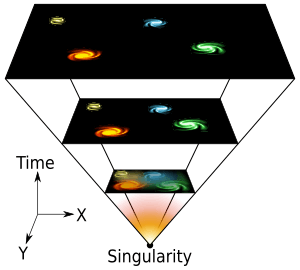Cosmogony facts for kids
Cosmogony is the study of how the universe began. It looks at different ideas and theories about where everything came from. It also explores how things like our Solar System or the Earth and Moon formed.
Contents
How the Universe Began: Scientific Ideas

In astronomy, cosmogony focuses on the birth of the universe. The most widely accepted scientific idea for the universe's start is the Big Bang theory.
This theory suggests that the universe began from a very tiny, super-hot, and super-dense point. Scientists call this point a singularity. When this singularity suddenly expanded, the Big Bang happened, and the universe began.
Scientists still have different ideas about where this original singularity came from. Some think it might be like a black hole, where gravity is incredibly strong.
Famous scientist Stephen Hawking had another idea. He suggested that "time" itself began with the universe. So, if time didn't exist before the universe, then the universe didn't really have a "before" or an "origin story" in the way we usually think of it.
We don't yet have a complete scientific model for the very first moments of the universe. This tiny period is called the Planck time. Scientists are still working on theories like string theory and M-theory to understand these earliest moments.
How the Universe Began: Mythical Stories
Many cultures around the world have their own stories about how the universe was created. These are called creation myths. They often explain the beginning of the world and everything in it.
These myths often include:
- A powerful supreme being or many gods.
- The universe being born from a union between male and female gods.
- The universe coming from a "cosmic egg."
One of the oldest known creation myths is the Eridu Genesis. It was written on ancient Sumerian tablets. This story says the universe was created from a vast sea. In Greek mythology, the god Zeus is sometimes credited with creating the universe.
Cosmogony vs. Cosmology
It's easy to confuse cosmogony with cosmology, but they are different.
- Cosmogony specifically studies the origin or beginning of the universe.
- Cosmology is a broader study of the universe in general. It looks at its structure, how it changes, and its future, not just its start. You can study the universe without focusing on its origin, which is what cosmology does.
Images for kids
-
The Sumerian tablet containing parts of the Eridu Genesis.
See also
 In Spanish: Cosmogonía para niños
In Spanish: Cosmogonía para niños


